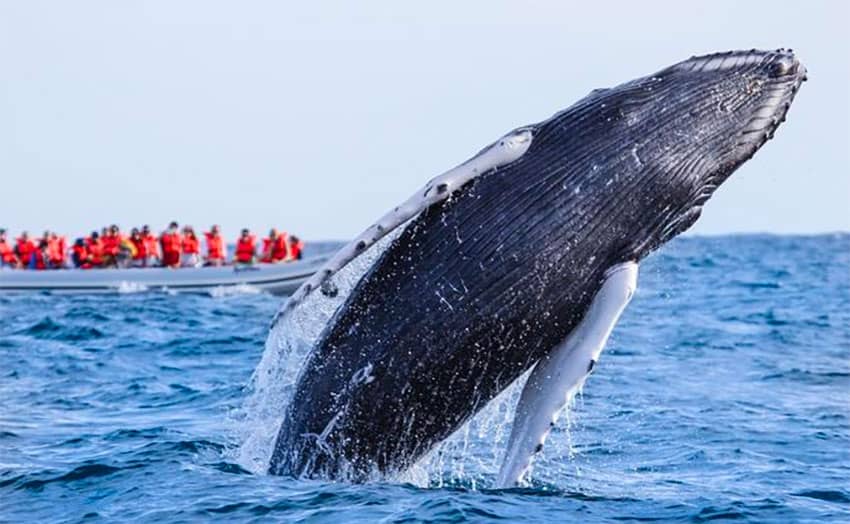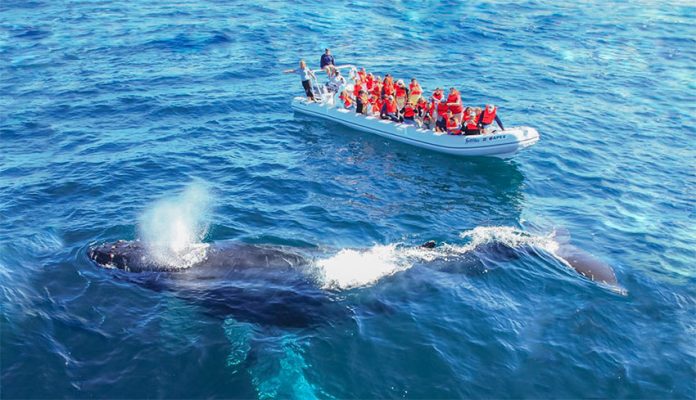It’s whale-watching season in Mexico as the pacific gray, humpback and blue whales migrate to Mexican territorial waters to breed.
Officially designated observation areas are located in Baja California, Baja California Sur, Nayarit, Jalisco, Sinaloa, Sonora, Oaxaca and Guerrero, where the whale-watching season runs from mid-December to the end of March, depending on the location. In some areas the season doesn’t end till May.
The most common whale to winter in Mexico is the Pacific gray whale, which is seen over much of the Pacific coast, and the humpback whale, which is mostly found in the Gulf of California. A third species, the blue whale, can be seen in Bahia de Loreto, Baja California Sur. The whales migrate each winter to the warm waters here to breed, coming from feeding grounds near Canada and Alaska.
The whales can get as close as 200-500 meters from the beach, making it possible to see them from the shore. But whale-watching season usually means getting on a boat for an even closer look. During the season, many fishermen take a break from fishing and become tour operators. Since the 1980s, this has become an important economic activity for a number of coastal communities, especially those whose fish stocks have been depleted.
The Mexican government considers whale-watching tours to be an economically sustainable activity, but regulates it nonetheless. In certain sensitive areas, all human recreational activities, especially water sports, are prohibited.

Tour operators must be licensed and are restricted to the types of boats they may use, how they may approach the whales and how close they can get. However, enforcement of the rules is typically not quite as it should be, although following them reduces the stress on the animals and protects their life cycle.
While there are rules about how close humans may approach the animals, there are no rules governing how close animals may approach humans. Although never guaranteed, it is possible for these giants to get right up to the boat.
The whales of one lagoon, San Ignacio in Baja Californa Sur, are particularly noted for their interaction with humans. This phenonmenon has been documented at least since the late 1970s. Sometime before that, the story goes, one curious whale in this lagoon approached a fishing boat close enough to be touched, and one fisherman did.
It was the start of a kind of truce and agreement between the whales and the local population. Today, the whales in this lagoon are so comfortable with human contact that if you do not rub their head, scratch their tongues or splash water on them, they will quickly lose interest in you. Mothers even push their calves over to waiting and very willing humans.
This situation is not the norm for whale-watching in Mexico or anywhere else and is limited only to this lagoon. These same whales will not approach boats after they leave to head back north.
The success of whale-watching is significant after considering that whales, especially gray whales, were nearly hunted to extinction in the 19th century. At that time, locals called the whales “devil fish” because the mothers would attack small whaling boats after their offspring were harpooned. Those approaching boats today are the descendants of those few who survived that period.
Gray whales have since bounced back to an estimated 20,000 in the wild, but they are still classified as being of special concern by the Canadian government. Experts advise caution when interacting for the safety of both whales and humans.
Source: 20 Minutos (sp), El Universal (sp), Los Angeles Times (en)
